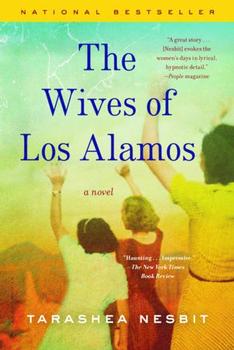Reading Guide Questions

Please be aware that this discussion guide will contain spoilers!
- The Wives of Los Alamos is narrated in first person plural. While individual women are mentioned, the wives speak as a group. How does this affect your understanding of them and their story?Do you come to knowany of them as individuals?What was your emotional response to this stylistic choice?
- From the very beginning, the town of Los Alamos is one defined by secrets. Who is keeping information secret from whom? What type of information does each group within the community have access to and how does that information give them power?
- Where do you see issues of race and class come up in the novel? Do race and class differences manifest themselves differently in this small, isolated community than they do in the world at large?
- The wives of Los Alamos are often pregnant, their families steadily growing. What does it mean to be a mother in this community? What do you think it would be like to grow up in that environment, only to move back into the world after the bombs had been dropped?
- In the days approaching the test of the atomic bomb, the husbands become increasingly distant. The wives are quick to wonder if the men have taken a lover, or if perhaps, in their isolation, they've let themselves go too much. How does this reflect back on the wives' roles in Los Alamos? And in their marriages?
- At times the wives seem to use their sexuality as a means of gathering information or making a social statement. Where do you see that come up in the book? In these instances, are they acting individually or as a group?
- When the wives watch the test bomb explode, they think, "our town had made something as strong and bright as the sun" (181). Has this been a communal creation?If it has been, what does it suggest about the accountability of all of the residents of the town going forward?
- Regarding the creation of the bomb, the wives note, "On this place formed millions of years ago by a huge eruption, our husbands had just made their own" (181). What is suggested in that comparison about the forces of creation and destruction? Was the bomb part of an on-going cycle, or was it a disruption of one?
- The wives have very different responses to the bombing of Hiroshima and Nagasaki. What are those responses? Are you able to relate to all of them, or are there some you have trouble understanding?
- Nesbit often mixes mundane details of everyday life with the monumental events discussed in the novel. For example, after the bombs are dropped in Japan, the wives exclaim, "You can build a bomb but you cannot fix a leaky faucet!" (187) How does this mixture of the quotidian with the tremendous change your understanding of these people and events?
- After Hiroshima and Nagasaki, the community in Los Alamos becomes the focus of national media. How do the wives respond to this attention?
- In the final days of the project, the Director, J. Robert Oppenheimer, says to the community, "If you are a scientist you believe that it is good to find out how the world works; that it is good to find out what the realities are; that it is good to turn over to mankind at large the greatest possible power to control the world and to deal with it according to its lights and its values" (189). Do you agree with that statement? What do you think the responsibility of a scientist is to society at large? Who should act as custodian to "the greatest possible power to control the world"?
- Oppenheimer ends his speech to the scientists and wives by saying, "A day may come when men and women will curse the name Los Alamos" (189). Do you curse the name? Why or why not?
- The scientists tell their wives shortly after Oppenheimer's speech, "The world knowing the bomb exists is the best hope for peace" (191). What do they mean by that? Do you agree?
- As the community of Los Alamos disperses, the wives observe: "Saying good-bye to our friends was not just saying good-bye to them,we were saying good-bye to part of ourselves"(207). What are they leaving behind as they leave Los Alamos? How has this experience changed them?
Suggested reading
The Girls of Atomic City by Denise Kiernan; The Making of the Atomic Bomb by Richard Rhodes; Hiroshima by John Hersey; American Prometheus by Kai Bird; The Ash Garden by Dennis Bock; The Buddha in the Attic by Julie Otsuka; Gone to Soldiers by Marge Piercy; Alas, Babylon by Pat Frank; Copenhagen by Michael Frayn; Refuge by Terry Tempest Williams; Ceremony by Leslie Marmon Silko; The Things They Carriedby Tim O'Brien
Unless otherwise stated, this discussion guide is reprinted with the permission of Bloomsbury USA.
Any page references refer to a USA edition of the book, usually the trade paperback version, and may vary in other editions.

 Book Reviewed by:
Book Reviewed by:



